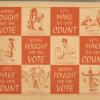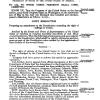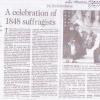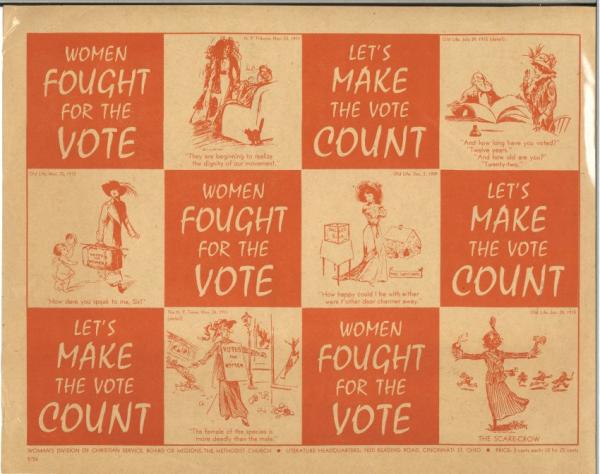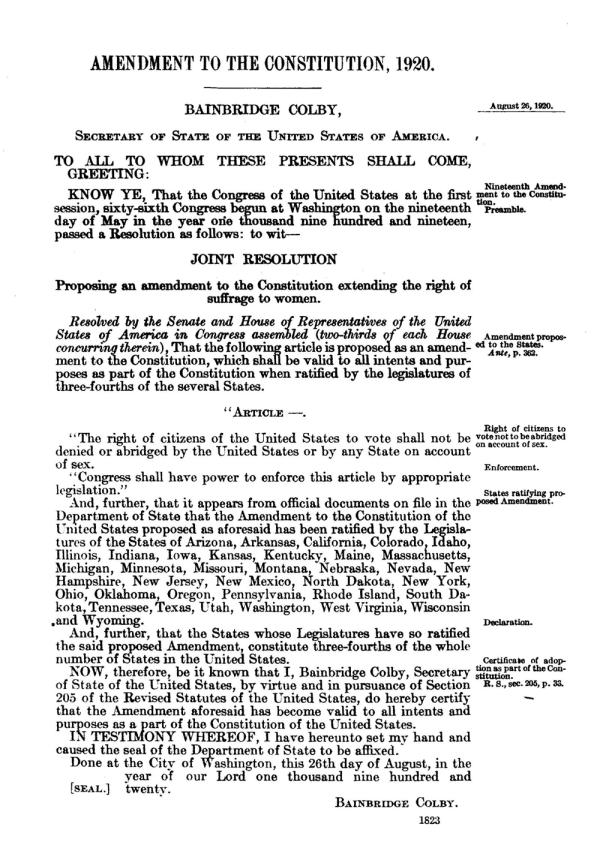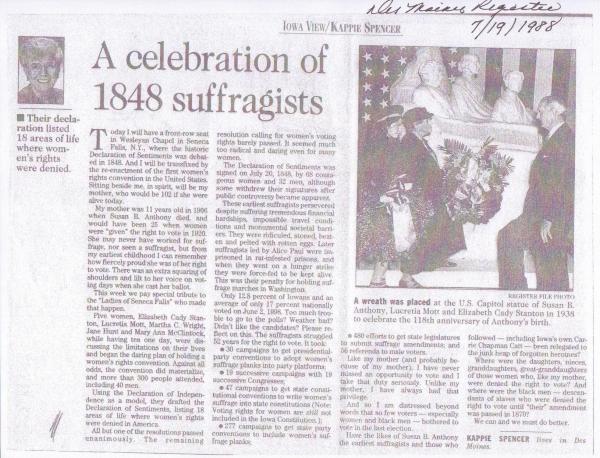Women's Suffrage in Iowa
| Grade | 9th -12th Grades | Class | U.S. History | Length of Lesson | 50 Minutes |
| Lesson Title | Women's Suffrage in Iowa |
| Unit Title | Influential Iowan Women |
| Unit Compelling Question | How influential were Women Suffragists in/from Iowa during the late 1800s and early 1900s? |
| Historical Context: In 2020, the United States will celebrate 100 years since women were insured the right to vote as citizens. When the United States became a new nation, not everyone had the right to vote. For the most part, only white men who owned property participated in elections. Native Americans, blacks, and men who didn't own land were not considered part of the political process. Women were expected to take care of the home and family. Men's role was to represent the family in public affairs. In 1848, a women's convention in Seneca Falls, NY, called for expanding the legal rights of women, including the right to vote. The issue gained more attention at the end of the Civil War when black men were allowed the right to vote but women, black or white, were not. Women's suffrage organizations formed to try to persuade legislators to change the law. In 1969, Wyoming became the first state to grant women the vote. There were some close votes in the Iowa legislature in favor of women's suffrage, but the cause was never completely successful. The law was changed to allow women to vote in bond issues and referenda where there were no candidates on the ballot but not in elections. In 1916, the legislature submitted a women's suffrage referendum to Iowa voters (all male), but it was narrowly defeated. Congress passed an amendment in 1919 mandating voting rights for women if it was approved by three fourths (36 of 48) of the states. Iowa was the 10th state to approve it. In August, 1920, Tennessee added the final tally, and women were allowed to vote in the Presidential election of that year. Women's suffrage was rarely considered on its own merits. For some, it represented too great a shift in the traditional gender roles. Were women qualified to participate in politics? Would it undercut men's authority in the home? The Bible states that the man is the head of the family and the wife should be subordinate. Debates on restriction of the sale of alcohol were a heated topic, resulting in the 19th Amendment to the U.S. Constitution in 1919 that prohibited its sale across the country. Opponents of prohibition were usually opponents of granting women the right to vote in fear that they would support stricter controls. Because of their support for schools and libraries, women were accused of favoring higher taxes which many opposed. On the other hand, women's suffrage groups argued that women had a right to vote in a country that boasted of equality-that all are created equal. They also pointed out the women had served faithfully in wartime and played an important part in community affairs. Women needed the vote, they argued, to insure clean and healthy communities for the welfare of their homes and children. As women's roles expanded, so did support for the full participation of women at the ballot box, but it took 75 years from the Seneca Falls convention to passage of the 19th Amendment. |
|
| Lesson Supporting Question | |
| Lesson Overview | This lesson will have students explore the women's suffrage movement and focus on the impact Iowa women had on the movement. They will evaluate some primary sources from Iowa during the suffrage movement and then research some influential Iowa women who made various significant contributions during the suffrage movement. They will be able to connect the primary sources and the historical women with the movement and Iowa's importance in the movement. |
| Primary Sources Used |
|
| Resources Needed |
|
| Standard | |
| Lesson Target | Students will be able to analyze how women impacted political and social institutions during the Suffrage movement.;Students will be able to evaluate the impact of women on political and social life in the United States.;Students will be able to assess the impact women and suffrage movement on change to civil rights and liberties.;Students will be able to evaluate Iowans (especially women from Iowa) who have influenced U.S. History. |
| Lesson Themes | Women's Experience |
|
| Formative Assessment (How will you use the formative assessments to monitor and inform instruction?) |
The source analysis worksheet will demonstrate the students' ability to accurately critique primary sources and find their significance beyond just what the source is and who it came from., The one page summary of an influential woman from Iowa will show the students the connections between the primary sources and their influence on history. While the sources may not be directly related to the woman they are researching they will be able to connect the influence women contributed to the suffrage movement. |
| Summative Assessment (How does the lesson connect to planned summative assessment(s)?) |
| Author | Kaitlyn Alsaihati | Created | Last Edited | ||||
| Reviewer: Chad Christopher, History Education, University of Northern Iowa | |||||||
| Lesson Plan Development Notes: Teaching Methods, University of Northern Iowa, Spring 2019 | |||||||

